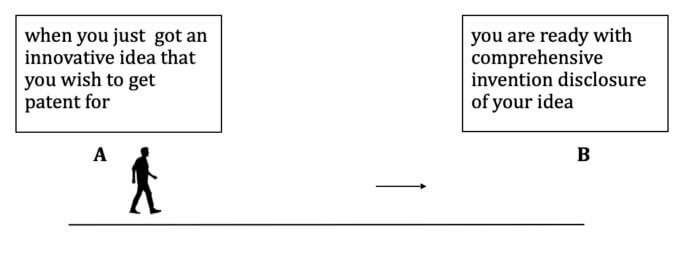Steps and Procedure for getting Patent in Japan
“Procedure for obtaining a patent in Japan has the following steps: capturing your idea for creating complete invention disclosure, conducting a patentability search, drafting a patent application, filing the application, publication of application, examination, Office action, responding to objections, and grant of the patent.”
Table of Contents
- Steps and Procedure for getting Patent in Japan
- Step 1: Going from idea to complete invention disclosure
- Step 2: Patentability search or Novelty search (optional step)
- Step 3: Patent drafting / Patent writing
- A good patent application should :
- Step 4: Filing a patent application
- Step 5: Publication of application
- Step 6: Examination of Patent Application
- Step 7: Response to objections
- Step 8: Grant of patent / Notice of Allowance
- Selecting right patent attorney for your invention
Step 1: Going from idea to complete invention disclosure
Every invention has its beginning in an Idea. In this phase, you capture your idea properly, get clarity on each element of the innovative idea, and fill-in the blank spots with appropriate research and experiment.

Preliminary search: this search is for finding answers to questions that build a working disclosure or comprehensive invention disclosure.
- What problem my invention is intended to solve? How does it work?
- What are the elements or components of my invention ?
- Can I draw a block diagram or device or flowchart or sketch that explains my invention in a better way ?
- How the elements or components are inter connected
- How each element is functioning in accordance with other element
- Can I search and collect information about all elements, parts or component of my invention so that there are no blank spots.
This is the most important phase for the inventor where we go from an idea stage to a working invention disclosure that can be discussed with a patent agent or attorney. we have a complete section about actions to take and worksheets Refer to the section Step 1 : from idea to invention disclosure.
Include drawings, diagrams, or sketches explaining the working of the invention. they play an important role in understanding your invention. Once you have your innovative idea completely captured with all technical details, then you perform a preliminary search.
Visit our Youtube channel https://www.youtube.com/@Patentattorneyworldwide
The outcome: of this step is a complete invention disclosure that covers all aspects of your invention without any missing elements or blank spots.
for more details, you may watch the video on what is exact information needed to file a patent application: creating complete invention disclosure
Approximate Patent Attorney Fees in Japan for stages like :
- Novelty Search 35810 JPY to 57300 JYP or (USD 250 to USD 400)
- Patent drafting and filing in 143240 JPY to 214860 JPY or (USD 1000 to USD 1500), after 1 to 2 years
- Response to office actions typically requires 71620 JPY to 143240 JPY or (USD 500 to USD 1000)
Step 2: Patentability search or Novelty search (optional step)
In this step, a comprehensive search is conducted to find out whether your invention meets patentability criteria in Japan which are :
- Novelty
- Non-obviousness
- Utility
The patentability search is aimed towards finding out the novelty and non-obviousness of the invention, the search identifies the closes possible prior arts (known to the public) relating to your invention, and based on the results obtained an opinion about the patentability of your invention may be provided by patent agent or attorney. The patentability opinion may be positive, negative, or neutral.
A positive patentability opinion indicates you stand a good chance to get your patent granted for your invention. This search (novelty or patetability) saves us from filing patent for an invention for which 100% overlapping prior arts are readily available to public. in such cases the patentability search would give a negative opinion. The patentability report and opinion helps you decide whether to go ahead with the filing of a patent or not, chances are what you thought as a novel might already have been patented or known to the public.
Novelty search or patentability search report saves lots of time, efforts and cost for you preventing you from filing an invention which is not Novel. therefore although optional it is a recommended step in patent procedure. For more details on this Refer section on ” novelty search or patentability search ”
Cost: the charges for conducting novelty search are in the range of 35810 JPY to 57300 JYP or (USD 250 to USD 400)
Time required: it takes about 2 to 5 working days for a researcher to complete a novelty search
The patent attorney generally prefers to have an independent opinion about the novelty search so most of them outsource it to a patent researcher.
Why patentability search or Novelty search is recommended (although optional step) ?
- The novel aspect of the invention identified via patentability search can be leveraged while writing patent application and especially claims of patent such that our patent application stands a good chance going through the examination stage to a granted patent.
- In case the patentability opinion is negative, then it saves a lot of cost and time which would have unnecessarily invested in proceeding with the patent filing process and eventually getting the patent application rejected.
- It helps you in taking decision whether to proceed with patent filing or not and estimating chances of getting patent for your invention.
Step 3: Patent drafting / Patent writing
A patent is a techno-legal document, that means patent has technical as well as legal aspects to it. Patent drafting / patent writing is a specialized job, it requires years of practice and experience with patent law as well as an understanding of the field of the invention, along with general understanding of case-laws and overall rules and regulations in patent prosecution to be able to draft a good patent application.
There are many rules and care to be taken while drafting claims, writing detailed descriptions, writing different embodiment of the invention, describing inventive step etc… which a first-timer or inexperienced patent writer may miss and hence end up not getting proper protection for invention (or sometimes even rejection of patent). Writing patent as a project report or a technical thesis (on your own ) and submitting it to patent office would be a mistake which can cause loss of opportunity to patent your invention.
To get a quick understanding, you may quickly read some granted patents from your field (domain) and realize that it is a complex document and it completely defers from a thesis or a project report written with ordinary skills.
A good patent application should :
Writing a good patent application is one of the most important step in life cycle of a patent and a good patent application written by an experienced patent agent / attorney should survive not only through the examination phase till the grant of patent but also it should survive the commercialization phase where actual money is made by licensing or selling patent rights, where competitors should not be able to work around your patent.
Writing such patent application is a skill and it is explained in detail in our section on “writing patent application (patent drafting)”
Cost of patent drafting in Japan : The cost for drafting a patent application in Japan varies in a great deal as it is dependent on multiple factors like field of invention and complexity and the cost is 143240 JPY to 214860 JPY or (USD 1000 to USD 1500)
Time required to draft a patent application in Japan : it takes about 1 to 2 weeks time for a patent attorney to draft an application for an invention. It certainly can take more time based on complexity, length of the detailed description, and availability of patent attorney’s time.
Step 4: Filing a patent application
the details about patent filing are explained in the section “filing patent application”
The official filing fees for patent application in Japan is JPY 14,000
When you are done with the review of the patent drafted and satisfied with the scope and technical details in the patent application, you can file the patent application at JPO, with appropriate forms with appropriate fees. Publication of patent application occurs after the expiration of an 18-month period following the earliest effective filing date or priority date claimed by an application.
Step 5: Publication of application
Patent application is published after the expiry of 18 months from the earliest filing date, however if requested by applicant the director may publish the patent application earlier than end of 18 month period.
Published patent applications can also be searched on the Japan Patent Office website.
Step 6: Examination of Patent Application
- Once your application has been accepted as complete, it will be assigned for examination. Your examiner will review the contents of the application to determine if the application meets the requirements.
- The objections raised on your patent application would be communicated with you, by an official letter from the JPO, known as an Office Action. You would get the opportunity to make amendments or contest the objections raised.
- There is a specific time within which you will have to respond to the objections, if you failed to do so the patent application will be abandoned.
In the examination stage of your patent application at JPO, a decision is made whether the invention should be patnted or not.
Request for Examination
| Attorney’s Fee (JPY) | Official Fee (JPY) | |
|---|---|---|
| Basic Fee (filed before March 31, 2019) | 14000 | 118000 |
| Basic Fee (filed after April 1, 2019) | 14000 | 138000 |
Step 7: Response to objections
Majority of patent applicants (inventors) will receive some type of objections based on examination report. The objections raised on your patent application would be communicated with you, by official letter from the JPO, known as an Office Action. You would get opportunity to make amendments or contest the objections raised.

The best thing to do it analyze the examination report with patent agent / attorney and creating a response to the objections raised. This is a chance for an inventor / applicant to communicate his side of the equation and making desired changes in the patent application to comply the objections received.
Office action refers to the written document issued by the JPO to highlight the examiner’s review of a patent application. in general, the information in office action communicates the acceptance or rejection of claims and residing reasons, prior arts, or any other specific reasons for its rejection.
When finding reasons for refusal, the examiner shall notify reasons for refusal by designating a predetermined time limit. When receiving a notice of reasons for refusal from the examiner, the applicant may submit a written opinion (Article 50).
Further, the applicant may make amendment to the description, etc. within the predetermined time limit. When the applicant submits a written opinion, a written amendment, etc., the examiner conducts an examination after sufficiently reviewing details of them.
Professional Fees: The patent attorney fee is 71620 JPY to 143240 JPY or (USD 500 to USD 1000) for response to office action depending upon complexity, subject matter, and the number of objections.
Step 8: Grant of patent / Notice of Allowance
As a result of the examination, the examiner will make a decision to grant a patent as the final assessment of the examination stage if no reasons for refusal have been found.
The examiner will also make the same decision if the reasons for refusal have been eliminated by an argument or amendment.
If the examiner determines that your application is in satisfactory condition and meets the requirements, you will receive a Notice of Allowance. The notice of allowance will list the issue fee also called registration fees and may also include the publication fee that must be paid prior to the Patent being issued. The patent grant is mailed on the issue date of the patent.
As a result of the examination, the examiner will make a decision to grant a patent as the final assessment of the examination stage if no reasons for refusal have been found. The examiner will also make the same decision if the reasons for refusal have been eliminated by an argument or amendment.
Provided that the applicant pays the patent fee, once the decision to grant a patent has been made the patent right will come into effect as it is entered in the Patent Register. At the same time, the invention acquires a patent number. After a patent is registered, a certificate of patent will be sent to the applicant.
Publication of Patent Gazette : The contents of the patent right entered in the Register will be published in the Patent Gazette.
Selecting right patent attorney for your invention
for more information on selecting the right patent attorney in Europe to work with and regarding deciding whether to go for a most expensive attorney or the most economical attorney for patenting your invention check our section on
